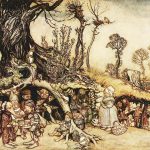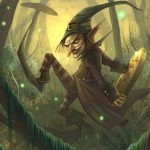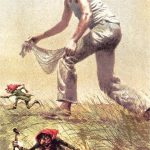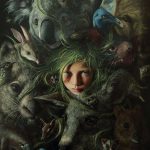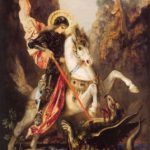In old Celtic fairy lore the sidhe (fairy folk) are immortals living in the ancient barrows and cairns. The Tuatha de Danaan are associated with several Otherworld realms including Mag Mell (the Pleasant Plain), Emain Ablach (the Fortress of Apples or the Land of Promise or the Isle of Women), and the Tir na nÓg (the Land of Youth).
Some 19th century archaeologists thought they had found underground rooms in the Orkney islands resembling the Elfland in Childe Rowland.
Those who do not live in the big cities tend to settle down in small packs of several families. There dwelling can sometime be recognized. The Gaelic belief recognizes no Fairyland or realm different from the earth’s surface on which men live and move. The dwellings are underground, but it is on the natural face of earth the Fairies find their sustenance, pasture their cattle, and on which they forage and roam.
Sithein is the name of any place in which the Fairies take up their residence. It is known from the surrounding scenery by the peculiarly green appearance and rounded form. Like a tumulus, it is nearly conical a form and covered with rich verdure. Its external appearance has led to its being also known by various other names.
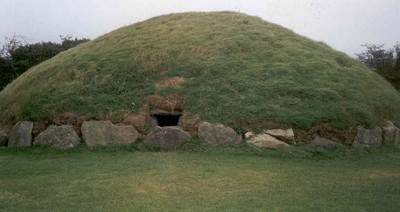
Brugh denotes the Fairy dwelling viewed as it were from the inside–the interiors–but is often used interchangeably with sithein. It is probably the same word as burgh, borough, or bro’, and its reference is to the number of inmates in the Fairy dwelling
These dwellings were tenanted sometimes by a single family only, more frequently by a whole community. The elves were said to change their residences as men do, and, when they saw proper themselves, to remove to distant parts of the country and more desirable haunts. To them, on their arrival in their new home, are ascribed the words:
“Though the good haven we have left,
Better be the haven we have found.”
The Fairy hillock might be passed by the strangers without suspicion of its being tenanted, and cattle were pastured on it unmolested by the “good people”.
There is, however, a common story in the Western Isles that a person was tethering his horse or cow for the night on a green tolman where a head a appeared out of the ground, and told him to tether the beast somewhere else, as he let rain into “their” house, and had nearly driven the tether-pin into the ear of one of the inmates.
Another, who was in the habit of pouring out dirty water at the door, was told by the Fairies to pour it elsewhere, as he was spoiling their furniture. He shifted the door to the back of the house, and prospered ever after. The Fairies were very grateful to any one who kept the shi-en clean, and swept away cow or horse-droppings falling on it.
Finding a farmer careful of the roof of their dwelling, keeping it clean, and not breaking the sward with tether-pin or spade, they showed their thankfulness by driving his horses and cattle to the sheltered side of the mound when the night proved stormy. Many believe the Fairies themselves swept the hillock every night, so that in the morning its surface was spotless.
Wales
The Welsh otherworld, roughly equivalant to the Irish faery land where the Tuatha de Danann dwelt.
In the Welsh tale “Pwyll Lord of Dyved” from the Mabinogion, it is told that Annwn was originally ruled by two great rival lords, Arawn and Havgan. However, a deal between Pwyll and Arawn led to Pwyll’s slaying of Havgan in combat, and from then on Arawn was sole ruler of that magical land.
However, in more recent legends and lore, Annwn becomes more the land of the dead, and its king is almost always Gwynn ap Nudd.
Sometimes spelt Annwfn or Annwvyn.
Long ago, on every New Year’s Day, a door would appear in the side of a great rock next to a certain lake. Those who entered found that it lead to a passage that ended on the island in the middle of the lake. This island was a beatiful garden kept by the Gwrgedd Annwn, who would serve wonderful food to the travelers and treat them as honored guests. They warned the fortunate mortals that the doorway was a secret and that nothing could be taken from the garden. One mortal took a single flower from the garden and as soon as he touched the soil of earth, all of the other other travelers were expelled and the doorway was closed, never to reopen again.
IN the prose Edda, Ganglar inquires what other cities beside that in which the Nornir dwelt were by the Urdar fount, under the Ash Yggdrasil. Hár replies:
“There are many fair cities there. There is the city which is called Alf-heim, where dwelleth the people that is called Liosálfar (Light Alfs). But the Döckálfar (Dark Alfs) dwell below underground, and are unlike them in appearance, and still more unlike in actions. The Liosálfar are whiter than the sun in appearance, but the Döckálfar are blacker than pitch.”

